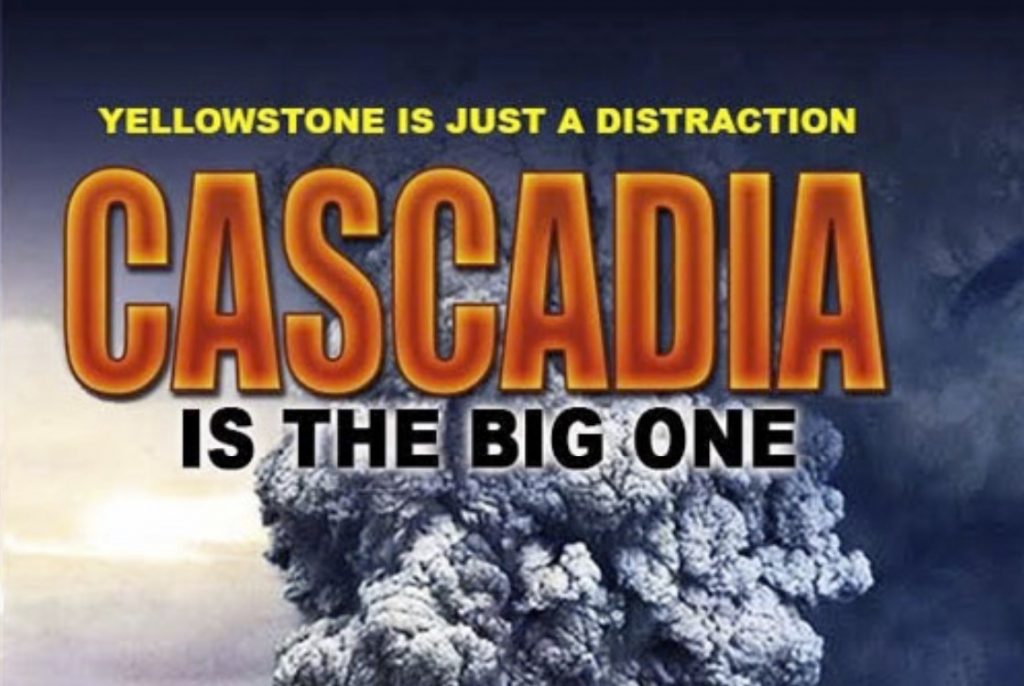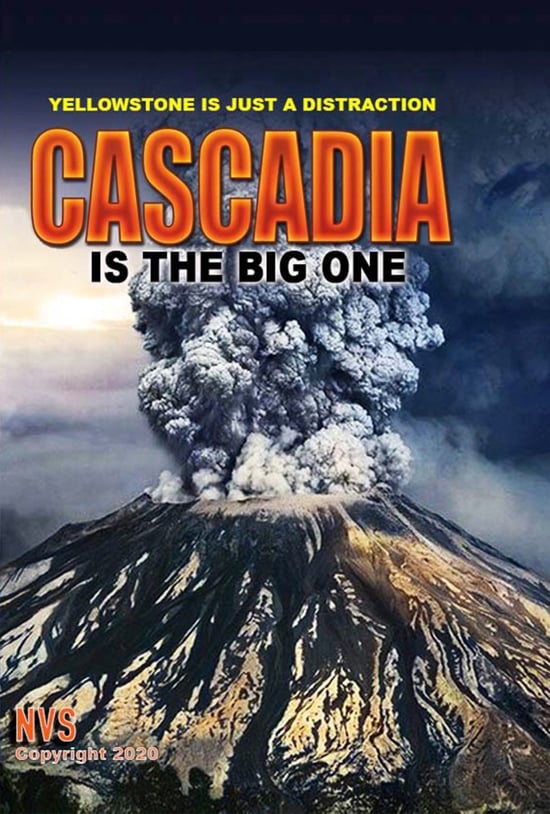Yellowstone supervolcano eruption rumors are back.
But it’s just a distraction… Cascadia is the real Big One!

As if a global pandemic wasn’t enough, some notable geologic events have also made headlines around the world, from earthquakes in Idaho and Utah to volcanic eruptions around the Pacific “ring of fire.”
It seems that any time calamity is in the headlines, often whether it has to do with the earth’s plumbing or otherwise, talk online inevitably turns to Yellowstone and the supervolcano that lies beneath the famed park and beyond.
You don’t have to spend too much time looking online to find fresh tabloid headlines warning about a possible eruption and predictions that the caldera will blow its top sometime in the next year.
The latest round of fear and rumor-mongering has little science to actually back it up, however, as the Yellowstone Volcano Observatory (YVO) lists the alert level for the Yellowstone Volcano as green or normal.
Idaho earthquake swarm
As aftershocks were still being felt from a magnitude 6.5 earthquake near Boise, the USGS office in Idaho took to Twitter Thursday to emphasize that the rattling in the region is not related to any volcanic activity in Yellowstone:
Once again, folks, Internet rumors aside, the recent #earthquakes in #Idaho and #Utah are NOT related to volcanic activity in #Yellowstone. Mike Poland, Scientist-in-Charge of the @USGS Yellowstone Volcano Observatory explains in this video.https://t.co/6Pp2D5RMCG
— USGS in Idaho (@USGS_Idaho) April 16, 2020
The Boise earthquake followed a magnitude 5.7 temblor in the Salt Lake City area just a few weeks earlier.
Mountain building strong earthquakes
YVO scientist-in-charge Mike Poland said in the below monthly update that the earthquakes are not tied to the Yellowstone supervolcano.
“These are actually related to mountain-building processes in the western US… those sorts of earthquakes are not uncommon for the region.”
It’s important to remember that this process obviously happens very slowly over eons. A similar magnitude earthquake happened in 1983 in the same area, which is half a lifetime for most of us, but just a second ago on geologic time scales.
Poland says it’s a good reminder that strong earthquakes are always a possibility throughout the western US.
It’s true that over 100 earthquakes, including a few “swarms” were reported in the Yellowstone region in March alone, which has fueled a lot of the fear and speculation about possible imminent eruptions.
What you won’t learn if you don’t read beyond the headline or dig deeper than a tweet, however, is that the strongest of those earthquakes was just a magnitude 3.1 and that this kind of activity is “pretty normal,” as Poland puts it.
Fears that earthquake activity (as well as full moons, asteroids, comets and just about anything else you can think of) will set off Yellowstone have been with us for years.
Last summer’s California tremors raised that anxiety, so it shouldn’t be surprising that strong quakes in neighboring states are getting people riled up again.
But the science states quite simply that no eruption is imminent at Yellowstone and when a real threat does begin to emerge, we’ll start to signs – at an absolute minimum – decades in advance.
The real threat is Cascadia
So yes! There are rumors of a Yellowstone supervolcano eruption going around.
But it’s just a distraction… Cascadia is the real Big One!
The Cascade Region of the Northwestern Coast of the USA boasts 11 of the 18 most dangerous volcanoes, yet the fervor over a Yellowstone explosion overshadows that very real threat of Cascadia.
“There’s a lot of excitement and interest in super volcanoes, like Yellowstone, and the potential that they could erupt in a catastrophic eruption, which has happened in the past. But that is pretty infrequent, even geologically speaking. What’s much more frequent, and what’s more likely to happen on a human length scale, is that one of the Cascade volcanoes will erupt,” explains Emilie Hooft, Associate Professor of the Dept. Earth Sciences of University of Oregon.
So now it’s time to get the real version of the story about the volcano threats on the U.S. West Coast and watch the most informative and spectacular documentary ever done on this subject here (click on the image below).

More earthquake news on Strange Sounds and Steve Quayle. [Vimeo, Forbes]













6.3 quakes in Japan and we have had many quakes over 5.5 plus indeed. We are ready for 8 plus in ring of fires.
Also still we have time May 5 2020. Until next full moon?
Now all stores will be closing you must order it on line if is available and then go pick up because USA citizens North Americans are failed to have social distance of 12 feet .
Experts say it may be time for grocery stores to ban customers from coming inside because of Covid-19
By Nathaniel Meyersohn, CNN Business
Updated 10:47 PM ET, Sun April 19, 2020
New York (CNN Business)Dozens of grocery store workers have died from the coronavirus, despite masks, temperature checks and capacity restrictions to keep them safe. So far, supermarkets have resisted the most draconian policy: banning customers from coming inside.
However, some worker experts, union leaders and small grocery owners believe it has become too dangerous to let customers browse aisles, coming into close range with workers. Grocery stores are still flooded with customers, and experts say it’s time for large chains to go “dark” to the public and convert to curbside pickup and home delivery for food and other essential goods.
“Careless customers” are “probably the biggest threat” to workers right now, according to Marc Perrone, president of the United Food and Commercial Workers’ union. The union said 85% of its grocery store member workers reported that customers are not practicing social distancing in stores.
“Anything that reduces the need for interaction with the public and allows for greater physical distancing will ultimately better protect grocery workers,” said John Logan, professor and director of Labor and Employment Studies at San Francisco State University. “Shuttering stores and repurposing them for pickup and delivery only would be a positive step.”
Many small, independent grocery stores have done this to protect their staff.
Mike Houston, general manager of Takoma Park Silver Spring Co-op in Takoma Park, Maryland, decided to close his grocery store to the public in late March, when the state announced a shelter-in-place order, and switch to curbside pickup.
“It was clearer that there was no real way to protect my staff and the public, especially as we served 960 people a day on average in a 4,200-square-foot store,” Houston said. “I’m unwilling to put grocery store employees, essential though we are, in a position to risk what can be a fatal infection.”
Whole Foods Market’s Bryant Park location temporarily closed to the public to focus on grocery delivery. The coffee and bar area has been repurposed for delivery storage.
Some large companies like Best Buy (BBY), which has a strong online infrastructure, have also switched over to this model during the crisis.
New regulations
Public safety officials are not requiring essential stores to shut down to customers, but the US Labor Department last week recommended that retailers start “using a drive-through window or offering curbside pick-up” to protect workers for exposure to coronavirus. The California Department of Industrial Relations said this week that companies should “encourage customer use of online order and pickup.”
Some big grocers are slowly starting to move in this direction. Whole Foods has closed down a store in New York City’s Bryant Park area and transitioned it into an online-only store, focused solely on deliveries. Kroger (KR) and Giant Eagle have switched a few stores to pickup and delivery-only locations.
But these are a fraction of stores in their wide networks. And most large chains have hesitated to shut down to the public. Instead, they are implementing more limited policies like taking workers’ temperatures and restricting the number customers inside stores at a time. Companies are calling on families to cut back on their trips to the store and shop alone if they can.
City and state governments are stepping in to force stricter safety measures than the companies have adopted. Los Angeles, Miami, Washington DC, New Jersey, Maryland and New York have ordered shoppers to wear masks or face coverings in stores. Vermont has required big box chains like Walmart to close down their “non-essential” sections like furniture, home and garden equipment and arts and crafts.
Will pickup and delivery-only work?
Some companies and safety experts say it’s not feasible to convert all grocery stores to delivery and pickup-only outposts. Ordering systems for both pickup and delivery are completely overwhelmed by a crush of demand from customers in many areas of the country.
“We have no choice. They have to stay open. [America’s grocery] delivery system has not matured to the point where we can switch to an entirely remote system,” said Seth Harris, former deputy secretary of labor during the Obama administration.
Online pickup and delivery requires a much larger staff than grocery stores are currently equipped with. That could fill supermarkets to capacity with workers, defeating the purpose of removing the public from stores.
Paying that many workers would also cost grocers a lot more money, and many smaller chains don’t have the resources. They have already hired more workers during the pandemic to meet demand, and they’re raising pay for existing employees to convince them to stay on the job. Grocers operate on razor-thin margins, and for many, the recent increase in sales because of coronavirus has been wiped out by the increases they’ve needed to make in payroll.
“I think that’s one of the major reasons chains are reluctant to do the switch,” said Logan from San Francisco State University.
A Trader Joe’s representative said that while “we understand that during this time customers would appreciate a delivery or pick up service,” the grocer’s “systems are not set up in a way that would allow us to be able to offer these services, and at the same time maintain our commitment to offering value to our customers.”
Switching to online pickup and delivery may also burden low-income customers who can’t afford fees that often come with these orders, customers without internet access and food stamp recipients. Most food stamp recipients are ineligible to use their assistance to purchase groceries online, although the Department of Agriculture has doubled the number of states that allow food recipients to order online in the past few weeks.
Because of lack of understanding for Americans. Seniors now have to pick up the groceries in designated areas coming soon.
AI and robots will change all of world.